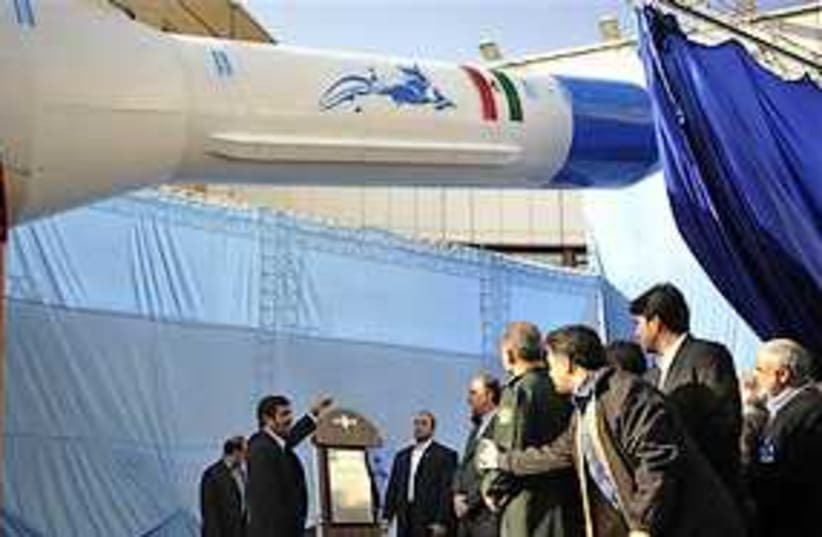Iranannounced Wednesday it has successfully launched a research rocketcarrying a mouse, two turtles and worms into space — a featPresident Mahmoud Ahmadinejad said showed Irancould defeat the West in the battle of technology.
Ahmadinejad also unveiled the model of a lightbooster rocket that is being built and three new, Iranian-builtsatellites, touted as the latest in the country's ambitious spaceprogram.
A US defense expert said the choice of animals servedno purpose but that the launch meant to boost the nation's confidenceand underlined the closeness of its space and military programs.
The Iranian space program has worried Western powers,which fear the same technology used to launch satellites and researchcapsules could also be used to build long-range intercontinentalmissiles and deliver warheads.
The launch of the rocket Kavoshgar-3, which meansExplorer-3 in Farsi, was announced by Defense Minister Gen. AhmadVahidi to mark the National Day of Space Technology. It comes a yearafter Iran sent its first domesticallymade telecommunications satellite, called Omid, or Hope, into orbitfor 40 days.
Iran's state TVbroadcast images Wednesday of officials putting a mouse, two turtlesand about a dozen creatures that looked like worms inside a capsulein the rocket, which appeared to be about 10 feet long, before itblast off.
Vahidi gave no details on the research and there wasno information on what experiment the animals would serve on board.The report also did not disclose when or where the launch took place.
Kavosghar-3 is the third in a series bearing the samename. Iran reported launchingKavoshgar-1, or Explorer-1, in Feb. 2008. The first section of therocket detached after 90 seconds and returned to earth with the helpof a parachute. A second segment entered space for about fiveminutes, while the final section was sent toward orbit to collectdata.
Later in 2008, a rocket entitled Kavoshgar-2, made itto the lower reaches of space and returned to earth 40 minutes lateron a parachute. No details about that launch were reported.
Ahmadinejad praised the latest launch and saidgreater events would come in the future.
"The scientific arena is where we should defeatthe (West's) domination," Ahmadinejad said in remarks broadcastlive on state TV. He said the launch is a "very big event. Thisis the first presence of animals in space launched by Iran.It's the start of bigger achievements" to come.
The model of the light booster rocket, named Simorgh,was displayed at a space show in Teheran, along with the three newIranian-built satellites — Mesbah-2, Tolo and Navid-e-Elm-o-Sanat.
Officials said the Simorgh rocket can carry asatellite weighing 220 pounds (100 kilograms) up to 310 miles (500kilometers) above the Earth. Ahmadienjad said the Simorgh would carryMesbah-2 into space but gave no timeframe for that.
As it seeks to expand its influence in the MiddleEast, Iran showcases its technologicalsuccesses as signs it can advance despite the threat of US and U.N.sanctions over its controversial nuclear program.
The West is concerned Iranis trying to build an atomic weapon but Teheran denies the charge andsays it's nuclear program is only for peaceful purposes, such aselectricity production.
"The launch was clearly part of Iran'seffort to advance military technology and assert political dominancein space," said James Lewis, senior fellow at Washington-basedCenter for Strategic and International Studies. "It's also ashow of confidence. Space rockets give you prestige and influence,and that is what Iran seeks."
Ahmadinejad said Iranbuilt the Mesbah-2 with domestic technology after foreign partnersrefused to cooperate. He didn't name any country, but Iransaid last year that it plans to launch a communications satellite bylate 2011 with no outside help, after Italy and Russia declined toput it into orbit.
Its predecessor, the Mesbah-1 satellite, was firstdisplayed in 2005. Iran planned tolaunch it the same year with Russian help but Moscow repeatedlydelayed providing a satellite-carrier.
"Mesbah-1 had a sad fate ... they didn't havethe courage to launch our satellite," Ahmadinejad said.
In 2005, Iran launchedits first commercial satellite on a Russian rocket in a joint projectwith Moscow, which is a partner in transferring space technology toIran. That same year, the governmentsaid it had allocated $500 million for space projects for the nextfive years.
Iran's lofty space plansalso include putting a man in orbit within 10 years but Lewis saidthe country seems to be a long way from that.
"If they had wanted to test a life-supportsystem, the obvious choice would be to send a monkey," saidLewis. "Worms in space serve no purpose."
The ceremony Wednesday was part of 10-daycelebrations leading up to 31st anniversary of the IslamicRevolution, which falls on Feb 11.
